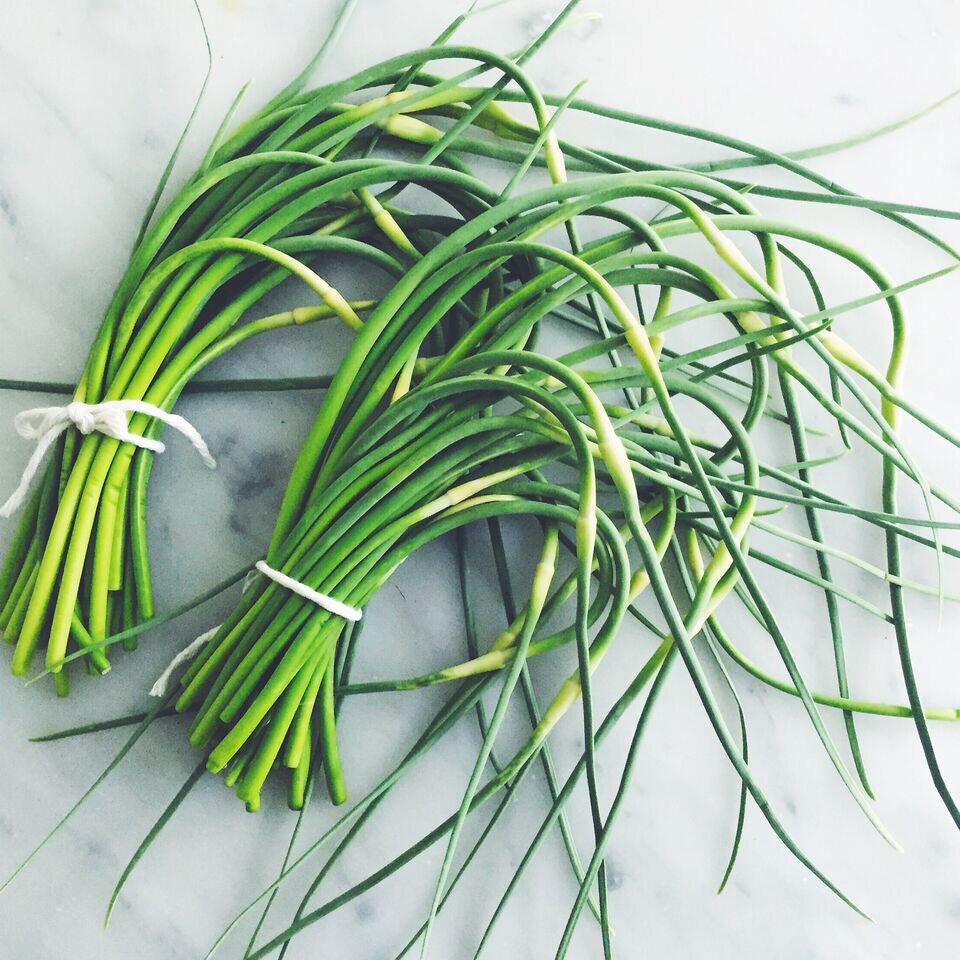Zolle Sott'Olio (Pickled Garlic Scapes)
Photo by Lauren Volo for Houghton Mifflin Harcourt
Pictured above is a jar of pickled garlic scapes ~ the swirly shoots and buds of the garlic plant. In Abruzzo they are called "zolle." They are a specialty of Sulmona, which is famous for its aglio rosso (red garlic). The shoots appear in June. Harvesting them allows the plant to focus its energy on bulb growth. Scapes are good in lots of recipes, including pesto, but I especially like to pickle them.
Preserving vegetables (and other foods such as fish) in oil is a classic Italian preserving technique ~ there is a chapter devoted to it my book “Preserving Italy.” The oil prevents the food's exposure to air; it also cuts the sharp flavor of the vinegar that the vegetable is first brined in.
In this recipe, typical of what you find around Sulmona, garlic scapes are cut into short lengths, plunged briefly into a boiling vinegar brine, and then submerged in olive oil. The garlic flavor in the pickled scapes is mild and lightly pungent. It goes particularly well with sheep's milk ricotta and pecorino, which you also find in abundance in Abruzzo. Serve pickled zolle as part of an antipasto platter, scramble them into a frittata, or scatter them on top of pizza. They also make a nice accompaniment to roast chicken or grilled beef.
If you'd like to learn a little more about the book, please tune in to my Splendid Table interview.
ZOLLE SOTT’OLIO (Pickled Garlic Scapes)
Makes 2 pints
Ingredients
1 pound garlic scapes
2 cups white wine vinegar (see NOTES)
1 teaspoon fine sea salt
Extra-virgin olive oil
Instructions
Have on hand 4 sterilized half-pint jars (or 2 pint-size jars) and their lids (see NOTES).
Cut the scapes into 1 1/2- to 2-inch lengths, removing any tought parts at the bottom and the thinnest part above the small bulbous tip.
In a saucepan large enough to hold all the scapes, bring the vinegar to a boil over medium-high heat. Stir in the salt and let it dissolve. Add the scapes to the pot and cover. Return the vinegar to a boil and boil, stirring once or twice, until the scapes have lost their bright green color and are just tender, 4 to 5 minutes.
Drain the scapes in a colander set in the sink. Spread on a clean kitchen towel and let dry for 1 hour. Shuffle them around once or twice during this time to make sure they dry on all sides.
Pack the scapes into the jars, leaving 1 inch head space. Pour enough olive oil into the jars to cover the scapes completely. Use a bubble remover or a clean chopstick to dislodge any air bubbles and press down on the scapes to submerge them.
Screw the lids on tightly and let sit at room temperature for 24 hours. Let the scapes cure in the refrigerator for 1 week before using, then store them in the refrigerator for up to 1 month. To serve, remove from the jar only as much as you plan to use and let it come to room temperature. Top off the jar with more oil as necessary to keep the remaining scapes submerged.
NOTES
These pickles have a pronounced vinegar flavor. If you want to soften the flavor, substitute up to 1 cup water for up to 1 cup of the vinegar ~ no more, as you do not want to dilute the preserving ability of the vinegar. You can also add a little sugar to the brine, if you like.
These pickles do not call for sealing in a water bath; they are stored in the refrigerator. However, to minimize the growth of mold or other micro-organisms, I prefer to sterilize the jars and lids. To sterilize jars, wash them with soapy water, rinse, and then boil in a water bath for 10 minutes; or wash in soapy water, rinse, and heat in a 285 F oven for 30 minutes. Wash the lids in hot soapy water, rinse, submerge in simmering water for a few minutes.


